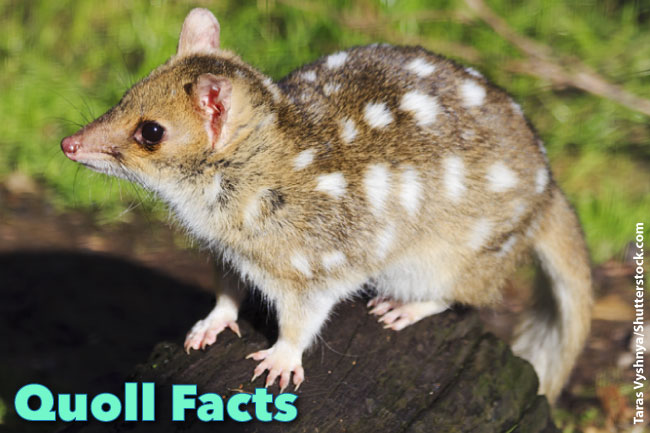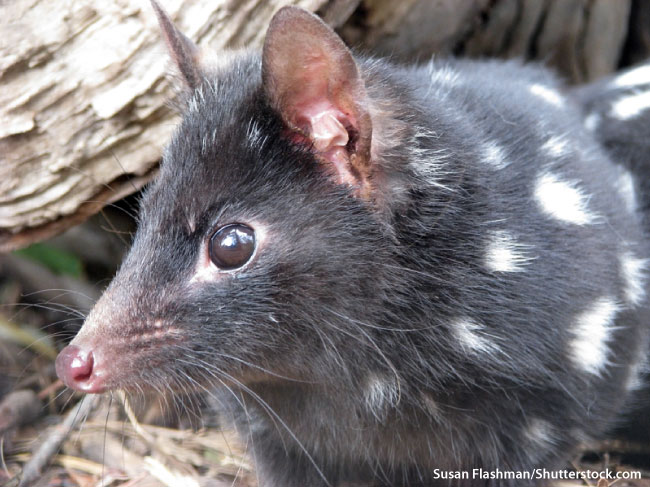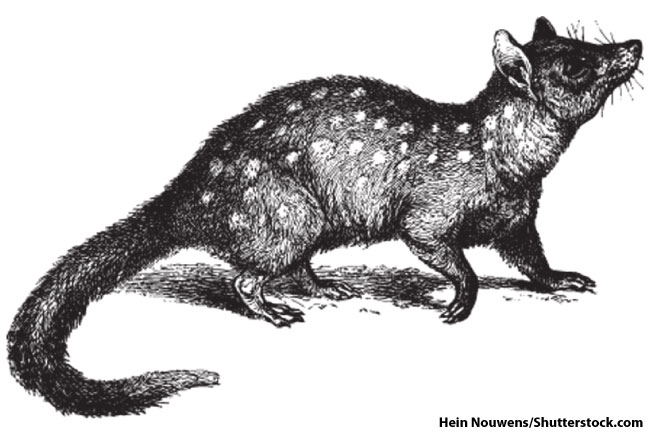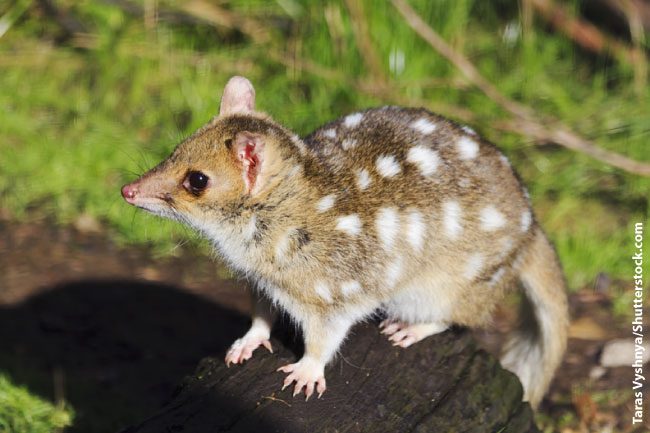The Quoll is a carnivorous marsupial. It is easily recognised by its distinctive pale spots. The quoll is native to Australia and New Guinea. It is threatened by habitat loss and the spread of invasive species (in particular the Cane Toad). This page contains quoll facts for kids and adults, and is part of our Australian Animals series.
Read on to find out all about this sharp-toothed marsupial …
Quoll Facts For Kids & Adults
- Quolls are carnivorous (meat eating) marsupials.
- Quolls are endemic to Australia and New Guinea (this means that they are only found in these areas).
- There are 6 species of Quoll; 4 are found in Australia, 2 are found in New Guinea.
- The largest species of Quoll is the Spotted-Tail Quoll (also called the Tiger Quoll), the smallest is the Northern Quoll.
- The Northern Quoll is rated ‘Endangered’ on the IUCN Red List. The other 5 species are rated ‘Near Threatened’.
- Quolls are easily identified by the spots on their fur.
- Quolls eat a range of animals, including insects, worms, lizards and rabbits. They will also feed on carrion.
- 'Quoll' is an Aboriginal name. Captain Cook saw Quolls in 1770, and heard local people using the name.
- Quolls are good climbers, and are often found in trees.
- Quolls are threatened by the spread of the poisonous Cane Toad and other non-native animals such as foxes.
- Male Northern Quolls don’t live for very long. In some areas all of the males die after the breeding season, leaving only the females and their young.
- Some people think that Quolls should be kept as pets, as this would increase their numbers.
What Do Quolls Look Like?
The quoll is around the size of a small cat. Its face is pointed, and its mouth is filled with sharp teeth. It has a moist, pink nose and bright eyes.
A quoll’s fur can range in colour from brown to black. Its coat is dotted with lighter patches. The spotted-tailed quoll is the only quoll species that also has spots on its tail.
The Quoll has ridges on the bottom of its feet to help it climb. It is unable to use its long tail to grip onto branches as monkeys do.
You can see an Eastern Quoll in the video below:
Nocturnal Hunters
The Quoll is mainly nocturnal, and tends to stay in its den during the day.
Quoll Species
There are six species of Quoll. Four are found in Australia and / or Tasmania, the other two are found in New Guinea. The six species of Quoll are listed below.
Are Quolls Endangered?
Five of the six species are rated ‘Near Threatened’ on the IUCN Red List, and one is rated ‘Endangered’.
Quolls Found In Australia (with IUCN rating)
- Eastern Quoll: Near Threatened. Found in Tasmania.
- Northern Quoll: Endangered. Found in separate colonies in northern parts of Western Australia and the Northern Territory, and in eastern Queensland.
- Spotted-Tail Quoll (also called Tiger Quoll) Near Threatened. The largest species of quoll. Found in southeast Australia and Tasmania. A separate subspecies is found in eastern Queensland.
- Western Quoll: Near Threatened. Found in southwest Western Australia.
Quolls Found In New Guinea (with IUCN rating)
- Bronze Quoll: Near Threatened
- New Guinean Quoll: Near Threatened
We’ll have a closer look at the 6 species of Quoll further down the page.
How Big Are Quolls?
There is quite a large size difference between Quoll species. The smallest Australian Quoll is the Northern Quoll, the largest the Spotted-Tailed Quoll. Northern quolls are the size of kittens, whereas Tiger Quolls are the size of full-grown cats or small dogs.
Tiger Quolls are the second largest carnivorous marsupial, and the largest on mainland Australia. The largest is the Tasmanian Devil, which is only found in Tasmania. Because of their long tails, Tiger Quolls are the longest carnivorous marsupial. Male Tiger Quolls can grow well over 1 metre (40 in) in length (including the tail).
Male Quolls are larger than females.
Marsupials
Marsupials are mammals that give birth to relatively undeveloped young. The young (called joeys) climb into their mother’s pouch immediately after being born. Here they continue to develop, while feeding on their mother’s milk, until they are ready to fend for themselves.
The only species of quoll to have a full pouch is the Tiger Quoll. The other species have folds of skin on their undersides which develop into a pouch during the breeding season.
Quolls give birth to more joeys than they can carry in their pouches, which can hold only six joeys. They other babies perish.
Quoll joeys spend around 2 months in their mother’s pouch. They are then carried around on her back for around 6 weeks. The young Quolls use their sharp teeth to cling on to their mother.
Quoll Facts For Kids: What Do Quolls Eat?
Quolls are carnivorous, which means they eat meat. The larger the quoll, the larger its potential prey. Smaller quoll species eat insects, worms, frogs, lizards and small mammals. The Tiger Quoll also eats larger animals such as Possums, Rabbits and Hares. Quolls will also eat carrion, fruit and grass.
Quolls And Cane Toads
Quolls are threatened by the spread of poisonous Cane Toads in Australia.
Cane toads were deliberately introduced in Australia in 1935. Farmers hoped that the amphibians would control the number of Grey-Backed Cane Beetles damaging their crops.
The scheme was unsuccessful. There are now millions of Cane Toads in Australia, and they are spreading out from where they were originally introduced. Native predators such as the Quoll have no natural defences against the toad’s poison.
Sadly, Quolls are likely to be tempted by a nice juicy Cane Toad. Upon eating a Cane Toad, a Quoll will become very sick or die. Along with habitat loss, the Cane Toad is one of the main reasons that Quolls are becoming endangered.
Watch the video below to find out more about the effect Cane Toads have on Quolls.
You can find out more about Cane Toads here: Cane Toad Facts.
Quoll Species
Eastern Quoll (Dasyurus viverrinus)
The Eastern Quoll is also known as an Eastern Native Cat. This medium-sized Quoll is now extinct in mainland Australia, but is widespread in Tasmania. Unlike all other Quolls, the Eastern Quoll only has four toes on its hind feet.
Northern Quoll (Dasyurus hallucatus)
The Northern Quoll is the smallest species of Quoll. All quolls have relatively short life spans, and the male Northern Quoll are particularly short-lived. In some areas, all adult male Northern Quolls die after the breeding season, leaving only female quolls and their young.
Spotted-Tailed Quoll (also called Tiger Quoll) (Dasyurus maculatus)
The Spotted-Tailed Quoll is also known as the Tiger Quoll. It is the largest Quoll, and the only one to have spots on its tail. There are two subspecies of Tiger Quoll. Dasyurus maculatus maculatus is found in southeast Australia, and Dasyurus maculatus gracilis is found in east Queensland.
(Subspecies are very closely related species. Differences between them are minimal, and they usually live in different places.)
Western Quoll (Dasyurus geoffroii)
The Western Quoll used to be found in 70% of Australia, but is now only found in a small area in southwest Australia. It is the second-largest Quoll. The Western Quoll is similar to the Eastern Quoll but has five toes on its hind feet.
Quolls Found In New Guinea
Little is known about the Quolls of New Guinea. The Bronze Quoll (Dasyurus spartacus) lives in the savanna and grasslands of southern New Guinea.
The New Guinean Quoll (Dasyurus albopunctatus) lives in the forests of northern New Guinea.
Quoll Facts For Kids Conclusion
We hope that you have enjoyed learning about this fierce little marsupial. You can learn about more amazing Australian animals here: Australian Animals.





